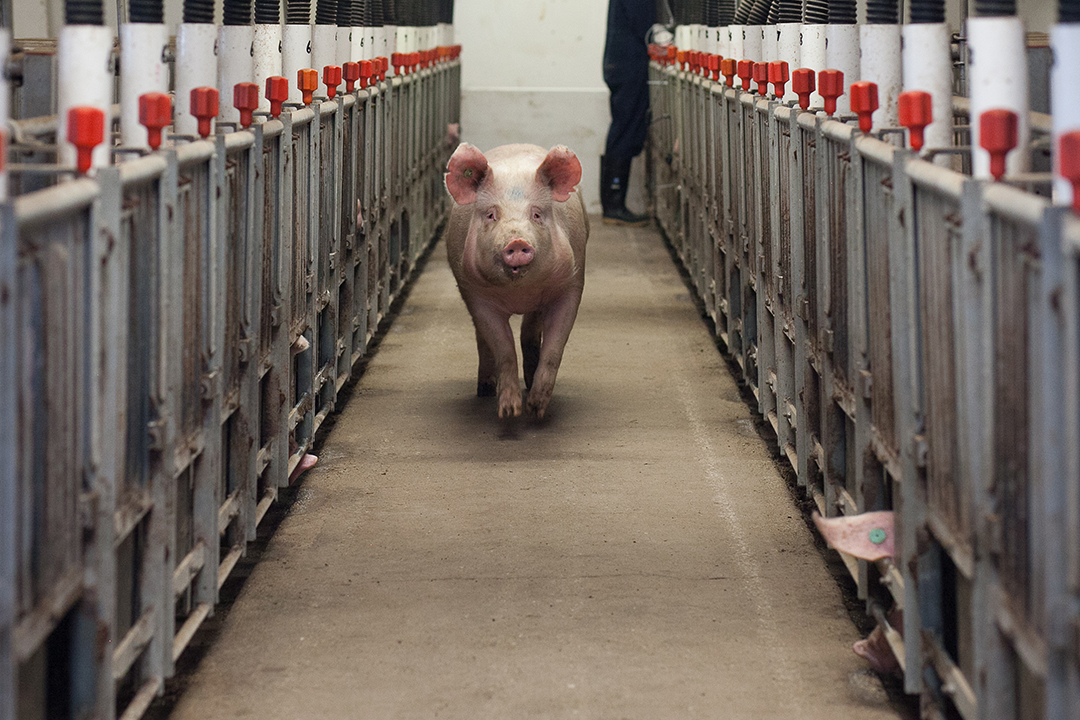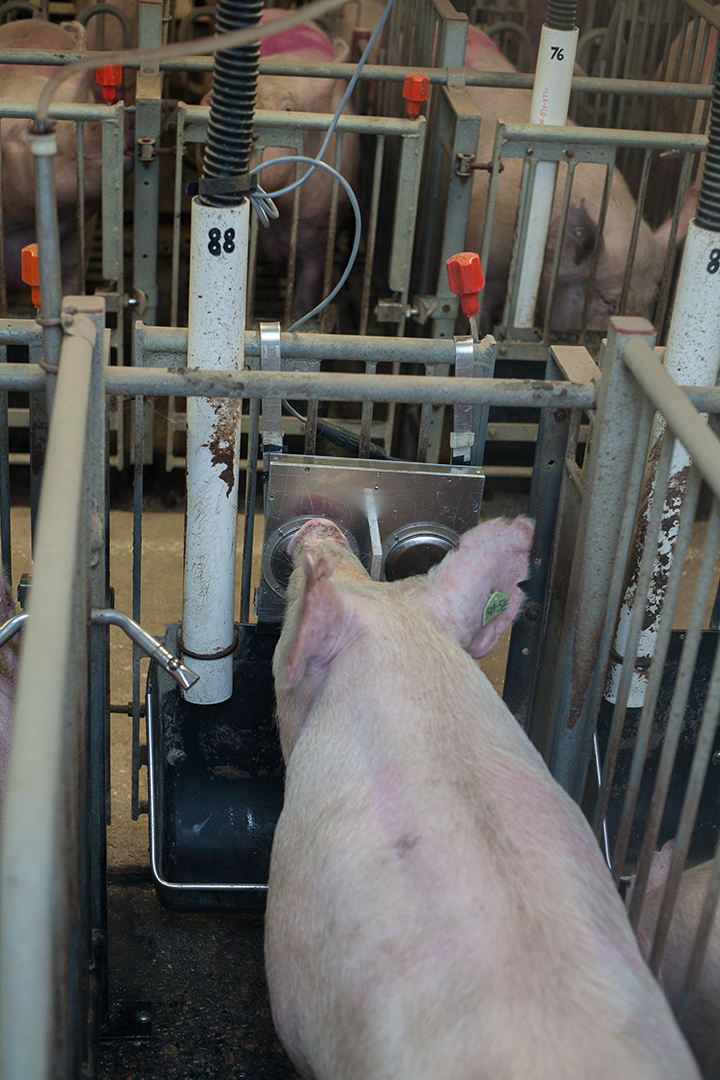
Do female pigs want to get fit or full?
Do stall-housed sows want to exercise? Or are they happy staying put and eating more? That’s one question swine ethologist Dr. Yolande Seddon and a team of researchers are working to answer.
By Michaella Barnes
The Western College of Veterinary Medicine (WCVM) scientists are conducting a study to determine whether stall-housed, bred pigs prefer to gain access to a greater freedom of movement or have access to more food.
The rationale for the research stems from the 2014 change in the requirements of the Canadian Code of Practice for the Care and Handling of Pigs, the nationally developed guidelines for the care and handling of farmed pigs.
The updated code required a major change. All barns newly built, renovated or brought into use for the first time after July 1, 2014, must house mated gilts (female pigs that have not yet reproduced) and sows (female pigs that have reproduced) in groups. However, existing stall barns in good working order can continue to house bred pigs in gestation stalls until it is time the barn is renovated.
As of July 1, 2024, the national code will require that all mated gilts and sows continuing to be housed in gestation stalls are provided with the opportunity to turn around and exercise periodically, or have access to other means that allow greater freedom of movement.
The code requires that the suitable options as to what constitutes a greater freedom of movement are to be clarified by participating stakeholders by July 1, 2019, as informed by scientific evidence.
However, the science on what could qualify as adequate greater freedom of movement is sparse. Additionally, it’s not known whether periodically providing a greater freedom of movement will bring measureable benefit to sow welfare.
Seddon, who is an assistant professor at the WCVM, also holds the NSERC Industrial Research Chair in swine welfare — a new position that’s supported by the Natural Sciences and Engineering Research Council of Canada, Canada’s swine industry and the University of Saskatchewan. She and her research tem are working to provide the scientific evidence that will establish whether opportunities for a greater freedom of movement are valued by stall-housed sows — and whether periodically providing greater freedom of movement will produce measureable benefits for sow welfare.
“It’s important to first ask the question: if a portion of sows will remain in stalls post-2024, and we want to improve their welfare, is this the right approach? It is key that changes to management will benefit sow welfare,” says Seddon.
While previous studies have determined that sows made to exercise at regular intervals have physiological changes that could benefit health, no one has conducted research to investigate whether stall-housed sows actually value a greater freedom of movement.
Animal welfare is dependent on how the individual animal feels. If periodic access to a greater freedom of movement is the only husbandry change that will be awarded to stall-housed sows to improve their welfare, knowing how strongly a sow values this access is central to decision making. It can help to identify if this is the best approach to improve the welfare of stall-housed sows.
Seddon and her research team set out to answer this question by conducting a motivation study – a scientific method that animal scientists use to determine how important the choices, or features, of the environment are to animals.
The research uses an operant panel. This device determines the strength of an animal’s motivation by allowing the animal to make a choice that triggers a reward.
The operant panel consists of a sheet of metal, mounted with two buttons, attached inside the gate of the sows’ stalls. Sows are trained to press one of the buttons; the reward for doing so is that the sow is released from the stall for three minutes of free movement.
Training continues so sows learn that they must press the button a greater number of times to keep receiving time out of the stall. Once sows have learned to press the button up to nine times, the sows begin to be tested daily for their motivation to exit the stall on an ascending fixed ratio, with the number of button presses that a sow must perform to exit the stall increasing each day.
When a sow fails to reach the set fixed ratio, the total number of button presses she achieved is a measure of her motivation to exit the stall. Following testing for freedom of movement, sows are retrained to associate pressing the operant panel with receiving a small quantity of feed. Testing continues to determine the comparative motivation of the same sows for a food reward.
By recording the number of times the sows are willing to press the button in each situation, the researchers can measure how hard the animals will work to gain access to each reward.
Identifying how strong the motivation for freedom of movement is compared to obtaining a resource that is known to be valuable – such as food – is important. It helps to gauge further understanding of the strength a sow’s motivation for freedom of movement.
The frequency at which a greater freedom of movement may need to be provided to have measurable benefits for the sow may be a real challenge to implement under commercial production conditions. For example, a large herd in Saskatchewan can include up to 6,000 breeding sows.
It’s important that code changes can be fully implemented, otherwise there will be minimal benefit to advance animal care and welfare.
“While individuals who are concerned about the confinement of animals would probably feel better to know that the sows in gestation stalls have periodic access to a greater freedom of movement, it also needs to be considered, how often can sows be given access to this in commercial farming operations and how will it benefit sow welfare,” says Seddon.
“If the provision of freedom of moment is too infrequent, perhaps it will not benefit sow welfare. We need to determine this to help informed decisions to be made with the confidence that they will bring improvement.”
Seddon adds that because a lot of countries have chosen to have group housing for gestating sows, many questions about the welfare of stall housed sows are no longer considered. “But if stalls continue to be used in the production cycle … it is something that should be considered.”
Improving sow welfare is a very important consideration for the swine industry, but the practicality of the future changes also needs to be considered. Seddon and her research group are optimistic that their study will help to contribute some much-needed science to help information stakeholder discussion on suitable options to improve the welfare of sows housed in gestating stalls after 2024.
Michaella Barnes of Canmore, Alta., is a U of S student (animal bioscience) who was part of the WCVM’s Undergraduate Summer Research and Leadership program in 2017. Michaella’s story is part of a series of articles written by WCVM summer research students.
